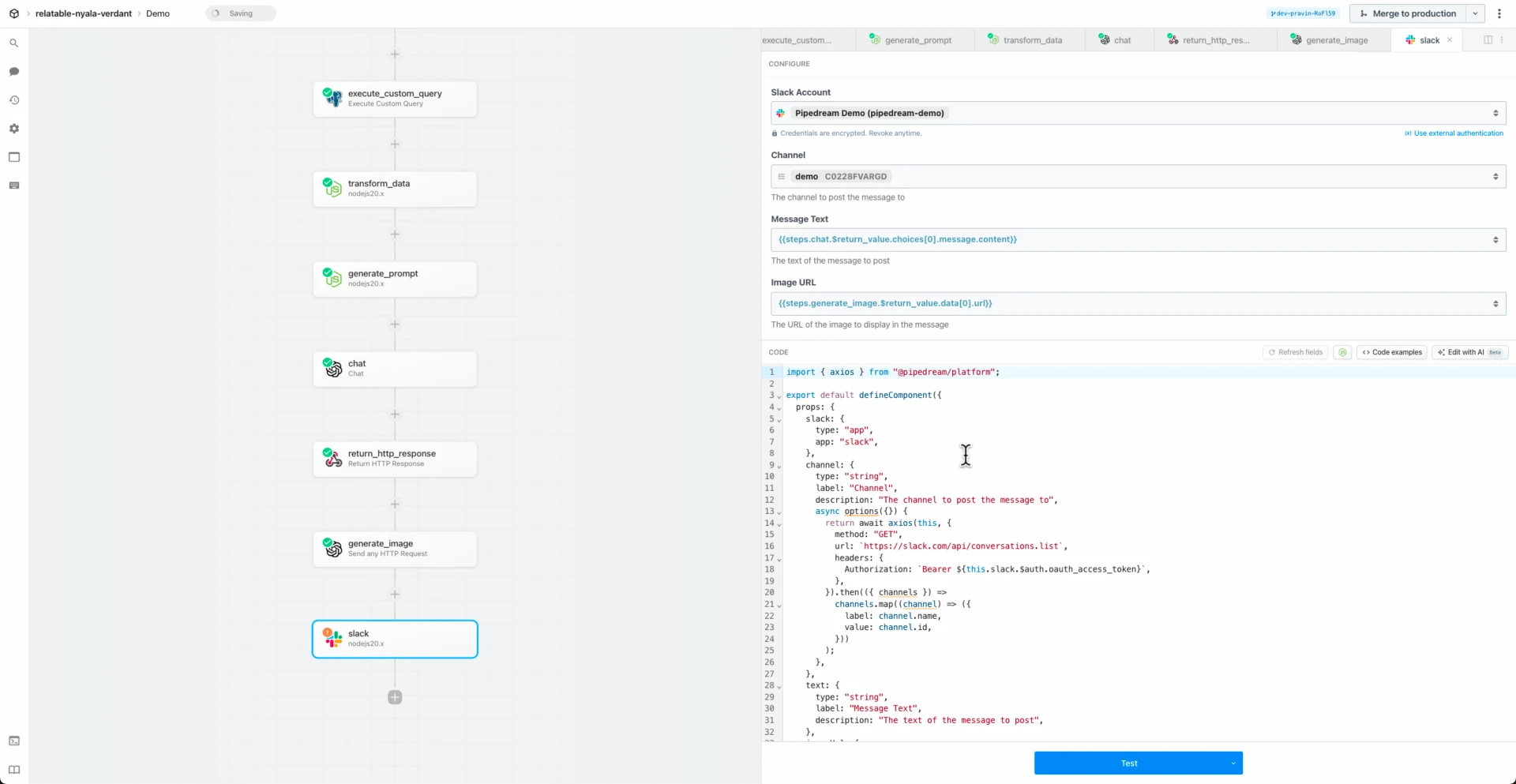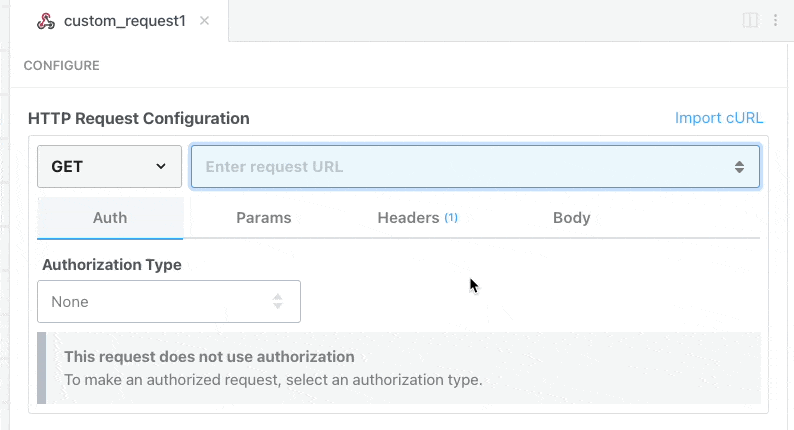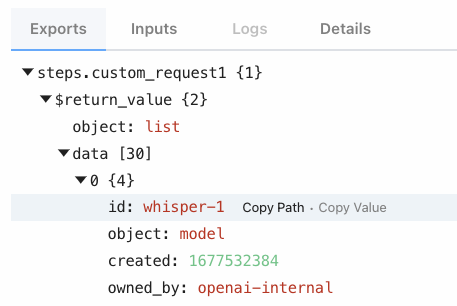import blotato from "../../blotato.app.mjs";
export default {
key: "blotato-create-post",
name: "Create Post",
description: "Posts to a social media platform. [See documentation](https://help.blotato.com/api/api-reference/publish-post)",
version: "0.0.1",
annotations: {
destructiveHint: false,
openWorldHint: true,
readOnlyHint: false,
},
type: "action",
props: {
blotato,
accountId: {
type: "string",
label: "Account ID",
description: "The ID of the connected account for publishing the post",
},
text: {
type: "string",
label: "Text",
description: "The main textual content of the post",
},
mediaUrls: {
type: "string[]",
label: "Media URLs",
description: "An array of media URLs attached to the post. The URLs must originate from the blotato.com domain. See the Upload Media section for more info.",
},
targetType: {
type: "string",
label: "Target Type",
description: "The target platform type",
options: [
"webhook",
"twitter",
"linkedin",
"facebook",
"instagram",
"pinterest",
"tiktok",
"threads",
"bluesky",
"youtube",
],
reloadProps: true,
},
additionalPosts: {
type: "string",
label: "Additional Posts",
description: "A JSON array of additional posts for thread-like posts (e.g., Twitter, Bluesky, Threads). Each post should have `text` and `mediaUrls` properties. Example: `[{\"text\": \"Second post\", \"mediaUrls\": []}]`",
optional: true,
},
scheduledTime: {
type: "string",
label: "Scheduled Time",
description: "The timestamp (ISO 8601 format: `YYYY-MM-DDTHH:mm:ssZ`) when the post should be published. If not provided, the post will be published immediately.",
optional: true,
},
},
async additionalProps() {
const props = {};
switch (this.targetType) {
case "webhook":
props.webhookUrl = {
type: "string",
label: "Webhook URL",
description: "The webhook URL to send the post data",
};
break;
case "linkedin":
props.linkedinPageId = {
type: "string",
label: "LinkedIn Page ID",
description: "Optional LinkedIn Page ID",
optional: true,
};
break;
case "facebook":
props.facebookPageId = {
type: "string",
label: "Facebook Page ID",
description: "Facebook Page ID",
};
props.facebookMediaType = {
type: "string",
label: "Media Type",
description: "Determines whether the video will be uploaded as a regular video or a reel. Only applicable if one of the media URLs is a video.",
options: [
"video",
"reel",
],
optional: true,
};
break;
case "instagram":
props.instagramMediaType = {
type: "string",
label: "Media Type",
description: "Is it a story or a reel? Reels are video only and cannot appear in carousel items. The default value is `reel`.",
options: [
"reel",
"story",
],
optional: true,
default: "reel",
};
props.instagramAltText = {
type: "string",
label: "Alt Text",
description: "Alternative text, up to 1000 characters, for an image. Only supported on a single image or image media in a carousel.",
optional: true,
};
break;
case "tiktok":
props.tiktokPrivacyLevel = {
type: "string",
label: "Privacy Level",
description: "Privacy level of the post",
options: [
"SELF_ONLY",
"PUBLIC_TO_EVERYONE",
"MUTUAL_FOLLOW_FRIENDS",
"FOLLOWER_OF_CREATOR",
],
};
props.tiktokDisabledComments = {
type: "boolean",
label: "Disabled Comments",
description: "If true, comments will be disabled",
};
props.tiktokDisabledDuet = {
type: "boolean",
label: "Disabled Duet",
description: "If true, duet will be disabled",
};
props.tiktokDisabledStitch = {
type: "boolean",
label: "Disabled Stitch",
description: "If true, stitch will be disabled",
};
props.tiktokIsBrandedContent = {
type: "boolean",
label: "Is Branded Content",
description: "If true, the post is branded content",
};
props.tiktokIsYourBrand = {
type: "boolean",
label: "Is Your Brand",
description: "If true, the content belongs to your brand",
};
props.tiktokIsAiGenerated = {
type: "boolean",
label: "Is AI Generated",
description: "If true, the content is AI-generated",
};
props.tiktokTitle = {
type: "string",
label: "Title",
description: "Title for image posts. Must be less than 90 characters. Has no effect on video posts. Defaults to the first 90 characters of the post text.",
optional: true,
};
props.tiktokAutoAddMusic = {
type: "boolean",
label: "Auto Add Music",
description: "If true, automatically add recommended music to photo posts. Has no effect on video posts.",
optional: true,
default: false,
};
props.tiktokIsDraft = {
type: "boolean",
label: "Is Draft",
description: "If true, post as a draft",
optional: true,
};
props.tiktokImageCoverIndex = {
type: "string",
label: "Image Cover Index",
description: "Index of the image (starts from 0) to use as the cover for carousel posts. Only applicable for TikTok slideshows.",
optional: true,
};
props.tiktokVideoCoverTimestamp = {
type: "string",
label: "Video Cover Timestamp",
description: "Location in milliseconds of the video to use as the cover image. Only applicable for videos. If not provided, the frame at 0 milliseconds will be used.",
optional: true,
};
break;
case "pinterest":
props.pinterestBoardId = {
type: "string",
label: "Board ID",
description: "Pinterest board ID. To get your board ID, go to the Remix screen, create a draft Pinterest post, and click 'Publish'.",
};
props.pinterestTitle = {
type: "string",
label: "Pin Title",
description: "Pin title",
optional: true,
};
props.pinterestAltText = {
type: "string",
label: "Pin Alt Text",
description: "Pin alternative text",
optional: true,
};
props.pinterestLink = {
type: "string",
label: "Pin Link",
description: "Pin URL link",
optional: true,
};
break;
case "threads":
props.threadsReplyControl = {
type: "string",
label: "Reply Control",
description: "Who can reply",
options: [
"everyone",
"accounts_you_follow",
"mentioned_only",
],
optional: true,
};
break;
case "youtube":
props.youtubeTitle = {
type: "string",
label: "Video Title",
description: "Video title",
};
props.youtubePrivacyStatus = {
type: "string",
label: "Privacy Status",
description: "Video privacy status",
options: [
"private",
"public",
"unlisted",
],
};
props.youtubeShouldNotifySubscribers = {
type: "boolean",
label: "Notify Subscribers",
description: "If true, subscribers will be notified",
};
props.youtubeIsMadeForKids = {
type: "boolean",
label: "Is Made For Kids",
description: "If true, marks the video as made for kids",
optional: true,
default: false,
};
props.youtubeContainsSyntheticMedia = {
type: "boolean",
label: "Contains Synthetic Media",
description: "If true, the media contains synthetic content, such as AI images, AI videos, or AI avatars",
optional: true,
};
break;
}
return props;
},
async run({ $ }) {
const {
accountId,
text,
mediaUrls,
targetType,
additionalPosts,
scheduledTime,
} = this;
const platform = targetType === "webhook"
? "other"
: targetType;
const content = {
text,
mediaUrls,
platform,
};
if (additionalPosts) {
try {
content.additionalPosts = typeof additionalPosts === "string"
? JSON.parse(additionalPosts)
: additionalPosts;
} catch (error) {
throw new Error("Invalid JSON format in Additional Posts");
}
}
const target = {
targetType,
};
switch (targetType) {
case "webhook":
target.url = this.webhookUrl;
break;
case "linkedin":
target.pageId = this.linkedinPageId;
break;
case "facebook":
target.pageId = this.facebookPageId;
target.mediaType = this.facebookMediaType;
break;
case "instagram":
target.mediaType = this.instagramMediaType;
target.altText = this.instagramAltText;
break;
case "tiktok":
target.privacyLevel = this.tiktokPrivacyLevel;
target.disabledComments = this.tiktokDisabledComments;
target.disabledDuet = this.tiktokDisabledDuet;
target.disabledStitch = this.tiktokDisabledStitch;
target.isBrandedContent = this.tiktokIsBrandedContent;
target.isYourBrand = this.tiktokIsYourBrand;
target.isAiGenerated = this.tiktokIsAiGenerated;
target.title = this.tiktokTitle;
target.autoAddMusic = this.tiktokAutoAddMusic;
target.isDraft = this.tiktokIsDraft;
target.imageCoverIndex = this.tiktokImageCoverIndex
? parseInt(this.tiktokImageCoverIndex)
: undefined;
target.videoCoverTimestamp = this.tiktokVideoCoverTimestamp
? parseInt(this.tiktokVideoCoverTimestamp)
: undefined;
break;
case "pinterest":
target.boardId = this.pinterestBoardId;
target.title = this.pinterestTitle;
target.altText = this.pinterestAltText;
target.link = this.pinterestLink;
break;
case "threads":
target.replyControl = this.threadsReplyControl;
break;
case "youtube":
target.title = this.youtubeTitle;
target.privacyStatus = this.youtubePrivacyStatus;
target.shouldNotifySubscribers = this.youtubeShouldNotifySubscribers;
target.isMadeForKids = this.youtubeIsMadeForKids;
target.containsSyntheticMedia = this.youtubeContainsSyntheticMedia;
break;
}
const data = {
post: {
accountId,
content,
target,
},
scheduledTime,
};
const response = await this.blotato._makeRequest({
$,
method: "POST",
path: "/v2/posts",
data,
});
$.export("$summary", `Successfully submitted post. Post Submission ID: ${response.postSubmissionId}`);
return response;
},
};
 Chase Roberts@chsrbrts@benedictevans If you haven’t used @pipedream yet, then you haven’t lived.
Chase Roberts@chsrbrts@benedictevans If you haven’t used @pipedream yet, then you haven’t lived. ✨Ellie Day✨@heyelliedayEvaluation update: @pipedream has quite literally been a dream to work with! I’m excited to leverage this tool for all the various workflows I need to write. I’m currently at 11k invocations a day from the initial workflows I’ve written in the past couple weeks.
✨Ellie Day✨@heyelliedayEvaluation update: @pipedream has quite literally been a dream to work with! I’m excited to leverage this tool for all the various workflows I need to write. I’m currently at 11k invocations a day from the initial workflows I’ve written in the past couple weeks. Michael Braedley@MBraedleyUpdate: I got it working properly, and it's working so well that I'm dropping IFTTT. @pipedream can do everything that IFTTT basic can, and most (if not all things) IFTTT pro can for free or at a reasonable price if you need it. I am recommending it for basically any power user.
Michael Braedley@MBraedleyUpdate: I got it working properly, and it's working so well that I'm dropping IFTTT. @pipedream can do everything that IFTTT basic can, and most (if not all things) IFTTT pro can for free or at a reasonable price if you need it. I am recommending it for basically any power user. Thomas Cutting@mrthomascuttingWant quick+dirty integrations for a serverless workflow - @pipedream is my new go-to 😃
Thomas Cutting@mrthomascuttingWant quick+dirty integrations for a serverless workflow - @pipedream is my new go-to 😃 Matthew Roberts@mattdotrobertsday 013 - finally hit node js. This is the secret sauce of taking #nocode projects that one step further. Pumped about getting deeper into @pipedream now
Matthew Roberts@mattdotrobertsday 013 - finally hit node js. This is the secret sauce of taking #nocode projects that one step further. Pumped about getting deeper into @pipedream now Kenneth Auchenberg 💭@auchenbergYahoo Pipes is back! Kinda 😍 @pipedream
Kenneth Auchenberg 💭@auchenbergYahoo Pipes is back! Kinda 😍 @pipedream Raymond Camden 🥑@raymondcamdenAwesome video by the @pipedream folks showing real time twitter sentiment analysis integrated with Google Sheets. This is where Pipedream *really* shines, connecting systems together in easy workflows.
Raymond Camden 🥑@raymondcamdenAwesome video by the @pipedream folks showing real time twitter sentiment analysis integrated with Google Sheets. This is where Pipedream *really* shines, connecting systems together in easy workflows. Nacho Caballero@nachocaballeroI couldn't recommend @pipedream more. It's an amazing service to integrate different APIs. Much more powerful than Zapier and more user-friendly than AWS Lambda. I'm very proud to wear this t-shirt #NoCode
Nacho Caballero@nachocaballeroI couldn't recommend @pipedream more. It's an amazing service to integrate different APIs. Much more powerful than Zapier and more user-friendly than AWS Lambda. I'm very proud to wear this t-shirt #NoCode Jason Snow@jyksnwDeveloped a working prototype environmental sensor IoT solution with @particle Photon, @pipedream, and @MongoDB with full graphing and alerting in less than a day! All amazing technology, will def. be exploring these more.
Jason Snow@jyksnwDeveloped a working prototype environmental sensor IoT solution with @particle Photon, @pipedream, and @MongoDB with full graphing and alerting in less than a day! All amazing technology, will def. be exploring these more. Steven Terrana@steven_terrana@burgwyn you've inspired me to finally set up my own blog. I'll make sure my first blog post explains the tech behind the setup. think @obsdmd + @GatsbyJS + @pipedream.
Steven Terrana@steven_terrana@burgwyn you've inspired me to finally set up my own blog. I'll make sure my first blog post explains the tech behind the setup. think @obsdmd + @GatsbyJS + @pipedream. 🚄 James Augeri, PhD@DotDotJamesWant to low-code your back end, need more horsepower than @Bubble / @KnackHQ, or just miss Yahoo! Pipes? Check out @PipeDream
🚄 James Augeri, PhD@DotDotJamesWant to low-code your back end, need more horsepower than @Bubble / @KnackHQ, or just miss Yahoo! Pipes? Check out @PipeDream Sébastien Chopin@AtinuxGitHub issues should be like @linear_app for maintainers. Looking forward more integrations with GH actions or tools like @pipedream 👀
Sébastien Chopin@AtinuxGitHub issues should be like @linear_app for maintainers. Looking forward more integrations with GH actions or tools like @pipedream 👀 Raul@raul_predescuIf you're a dev and not using @pipedream, you're missing out. Been using it for months, daily. FREE for devs. Plenty of integrations and good limits. Absolutely love it.
Raul@raul_predescuIf you're a dev and not using @pipedream, you're missing out. Been using it for months, daily. FREE for devs. Plenty of integrations and good limits. Absolutely love it. Bruno Skvorc@bitfallsSo @pipedream is pretty amazing. In 3 minutes I just made a flow which adds @rickastley's Never Gonna Give You Up to my @spotify playlist whenever a new pull request arrives in an old repo of mine.
Bruno Skvorc@bitfallsSo @pipedream is pretty amazing. In 3 minutes I just made a flow which adds @rickastley's Never Gonna Give You Up to my @spotify playlist whenever a new pull request arrives in an old repo of mine. Zach Lanich@ZachLanichUm, wow 🤯 @pipedream
Zach Lanich@ZachLanichUm, wow 🤯 @pipedream Steven Bell@bellontechI just used @pipedream to build a Shopify App. Wow, they make small backed tasks easy.
Steven Bell@bellontechI just used @pipedream to build a Shopify App. Wow, they make small backed tasks easy. Jay Hack 🎩🇺🇸@_jayhack_Very impressed with this bad boi - it reminds me of a @PalantirTech internal tool, but geared towards integrations instead of data analysis and far more customizable. Great expectations here 🚀🤩
Jay Hack 🎩🇺🇸@_jayhack_Very impressed with this bad boi - it reminds me of a @PalantirTech internal tool, but geared towards integrations instead of data analysis and far more customizable. Great expectations here 🚀🤩 Tree Sturgeon 🔥🚴♂️🌳@philsturgeonFor context this is day 2 of a really challenging and stupid migration from Notion to @airtable with disparate/missing data. It's going better than expected and thanks to @pipedream I don't have to bother the iOS dev to add W3W.
Tree Sturgeon 🔥🚴♂️🌳@philsturgeonFor context this is day 2 of a really challenging and stupid migration from Notion to @airtable with disparate/missing data. It's going better than expected and thanks to @pipedream I don't have to bother the iOS dev to add W3W.




